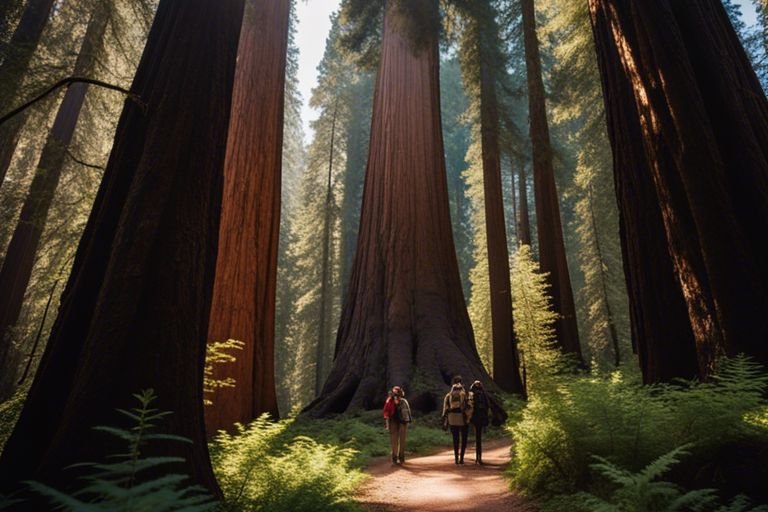Types of Redwood Trees in California
The redwood trees in California can be classified into two main types: the Coastal Redwoods and the Giant Sequoias. Each of these types has its own unique characteristics and can be found in different regions of California.
| Type | Region |
| Coastal Redwoods | Coastal areas of Northern California |
| Giant Sequoias | Sierra Nevada mountain range in eastern California |
Coastal Redwoods
The Coastal Redwoods are the tallest living trees on Earth and can reach heights of over 300 feet. They are found in the coastal areas of Northern California and are known for their straight, cylindrical trunks and massive size. These trees thrive in the cool, moist climate of the region and are a sight to behold for anyone visiting the area.
Giant Sequoias
The Giant Sequoias are some of the most massive trees in the world and can live for thousands of years. They are found in the Sierra Nevada mountain range in eastern California and are known for their massive girth and reddish-brown bark. These trees are a testament to the power and resilience of nature and are a popular attraction for hikers and nature enthusiasts.
Key Takeaways:
- Largest Redwood Trees: The article showcases the magnificent size and awe-inspiring beauty of the largest redwood trees in California.
- Environmental Importance: These giant trees play a crucial role in the ecosystem, providing habitat for numerous species and helping to mitigate climate change through carbon sequestration.
- Tourism and Conservation: The redwood forests attract tourists and nature enthusiasts, but also require conservation efforts to preserve these ancient giants for future generations.
- Protection and Management: The National and State Parks, as well as other conservation organizations, work tirelessly to protect and manage the redwood forests to ensure their longevity.
- Awe-Inspiring Experience: Visiting these incredibly large trees can provide a profound sense of awe and connection to nature, inspiring a deeper appreciation for the natural world.
Tips for Finding the Largest Redwood Trees
One of the best ways to spot the largest redwood trees in California is to do your research beforehand. Look for information on the internet about the exact locations of these massive trees. Use online maps and guides to identify the best areas to visit. When you’re on the lookout for these giants, keep an eye out for areas with old-growth forests, as they are more likely to have the largest redwoods.
- Use online mapping tools to locate specific groves of giant redwoods
- Visit old-growth forests for a better chance of finding the largest trees
- Check out guidebooks and websites for insider tips on locating the biggest redwoods
Knowing the typical characteristics of redwood trees, such as their massive size, reddish-brown bark, and wide bases, can also help you in your search for these extraordinary giants.
Best National and State Parks to Visit
If you’re looking to explore the largest redwood trees in California, some of the best national and state parks to visit include Redwood National and State Parks, Humboldt Redwoods State Park, and Big Basin Redwoods State Park. These parks are home to some of the most impressive specimens of these majestic trees, and offer a variety of trails and attractions for visitors to enjoy.
Recommended Hiking Trails
When it comes to finding the largest redwood trees, embarking on a hiking adventure can be the best way to get up close and personal with these natural wonders. Some of the most iconic hiking trails for spotting giant redwoods include the Grove of Titans Trail, Lady Bird Johnson Grove Trail, and Founders Grove Nature Trail. These trails offer breathtaking views and the opportunity to witness the sheer magnitude and beauty of these ancient trees.
Step-by-Step Guide to Measuring Redwood Trees
Some of the most awe-inspiring natural wonders in California are the towering redwood trees. These giants can reach staggering heights, and measuring them accurately can be a challenging yet rewarding experience. To help you get started, I’ve put together a step-by-step guide to measuring redwood trees.
| Equipment Needed | Measuring Techniques |
|---|---|
| Tape Measure | Laser Range Finder |
| Clinometer | Trigonometric Methods |
| GPS Device | Dendrometers |
Equipment Needed
When measuring redwood trees, it’s important to have the right equipment to ensure accurate results. You’ll need a tape measure to measure the circumference of the tree, a clinometer to measure its height, and a GPS device to record its location. Additionally, a laser range finder can be useful for measuring the distance to the top of the tree, and a dendrometer can measure the diameter of the trunk at different heights.
Measuring Techniques
Once you have the necessary equipment, you can begin measuring the redwood tree. Using a combination of trigonometric methods and the tools mentioned above, you can calculate the tree’s height, diameter, and volume. It’s important to use caution when taking measurements, as climbing the tree or using a ladder can be dangerous. However, the experience of measuring these majestic trees is truly unforgettable and provides valuable data for conservation efforts.
Factors Affecting the Size of Redwood Trees
To understand what contributes to the immense size of redwood trees, it’s important to consider a few key factors. Environmental conditions, such as climate and soil, play a significant role in the growth of these majestic giants. Additionally, human impact has shaped the landscape and ecosystem in which these trees thrive. By examining these factors, we can gain a better understanding of what it takes for redwoods to reach such staggering heights.
- Environmental conditions
- Human impact
The relationship between redwood trees and their environmental conditions is undeniable. Factors such as temperature, precipitation, and soil composition all play a critical role in the growth and size of these trees. Redwoods thrive in moist, foggy climates and require well-drained, acidic soils to reach their full potential. The combination of these environmental conditions creates the perfect habitat for these towering giants to flourish.
Human Impact
While redwood trees have adapted to thrive in specific environmental conditions, human impact has also influenced their size and distribution. Historically, the logging industry has had a significant impact on redwood forests, leading to the destruction of vast areas of old-growth redwoods. While conservation efforts have been made to protect these remarkable trees, the legacy of human impact is still evident in the fragmented nature of many redwood forests today. It’s important to consider the ongoing effects of human activity on the size and distribution of redwood trees.
Pros and Cons of Visiting the Largest Redwood Trees
Now, as with any travel destination, there are both pros and cons to visiting the largest redwood trees in California. It’s important to consider both aspects before planning your trip so you can make the most informed decision.
| Pros | Cons |
| Unforgettable natural beauty | Crowded tourist areas |
| Opportunity for outdoor activities | Potential environmental impact |
| Educational and enlightening experience | Long travel distances |
| Awe-inspiring sense of scale | Challenges in finding accommodations |
| Connection to nature and history | Difficulty capturing the true size in photos |
Benefits of Experiencing Nature
Immersing yourself in the natural environment of the largest redwood trees can have numerous benefits for your physical and mental well-being. The serene and awe-inspiring setting allows you to escape from the hustle and bustle of modern life, providing a peaceful and rejuvenating experience. Breathing in the fresh air and feeling the earth beneath your feet can greatly reduce stress and foster a deeper connection with the natural world. Additionally, witnessing the grandeur of these ancient trees can inspire a greater appreciation for the environment and the need to protect it for future generations.
Potential Environmental Impact
While visiting the largest redwood trees offers an incredible opportunity to connect with nature, it’s important to consider the potential environmental impact of increased tourism. The delicate ecosystems surrounding these majestic trees can be vulnerable to damage from excessive foot traffic, littering, and other human disturbances. Additionally, the carbon footprint of traveling to these remote locations should be taken into account, as it contributes to the overall impact on the environment. It’s crucial to be mindful of your actions and minimize your ecological footprint when visiting these natural wonders.
FAQ
Q: What are the largest redwood trees in California?
A: The largest redwood trees in California are the giant sequoias, also known as the Sierra redwoods. These massive trees can reach heights of over 300 feet and have a circumference of 30 feet or more.
Q: Where can I find the largest redwood trees in California?
A: The largest redwood trees in California can be found in several locations, including Sequoia National Park, Kings Canyon National Park, and Redwood National and State Parks.
Q: How old are the largest redwood trees in California?
A: The largest redwood trees in California are estimated to be between 2,000 and 3,000 years old. Some individual trees are even older, with estimates of up to 3,200 years old.
Q: What is the best time of year to visit the largest redwood trees in California?
A: The best time to visit the largest redwood trees in California is during the spring and summer months, when the weather is mild and the trees are in full bloom. Fall is also a great time to visit, as the changing colors of the leaves create a stunning display.
Q: Are there guided tours available to see the largest redwood trees in California?
A: Yes, there are guided tours available at many of the national and state parks where the largest redwood trees are located. These tours are led by knowledgeable guides who can provide valuable insight into the history and ecology of these magnificent trees.




